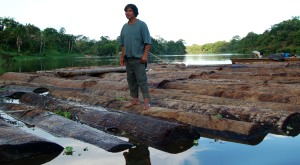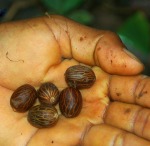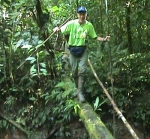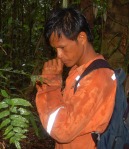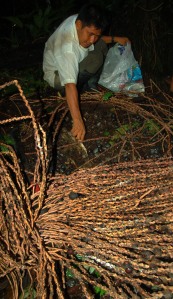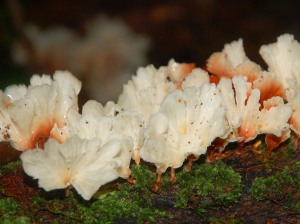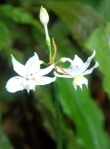My mosquito net did its job well last night but it provided no respite against the cacophony of roosters that began their competing calls before dawn. I was at least spared spasms of cramps that sometimes also make it difficult to lazily enjoy the last hour of dozing before rising in the cool Amazon morning.
I got up around 6:00 am and spent the requisite 20 minutes stretching my right shoulder. I had a towel to pull my hand up behind my back, and I have improvised other props common at my physical therapist office. I used a heavy wooden pole in place of a cane and made like Bruce Lee moving my hand around in circles clutching a water bottle in clock-wise and counter clock-wise directions in place of a giant wheel mounted on a wall. I didn’t have to worry today about not jogging as I normally do at home. Walking through the forest for seven hours would be plenty of exercise.
I joined the copal team that Yully and Beder had assembled yesterday that included two older fellows Aurelio (Marcelina’s husband) and Carlos, Beder’s brother Brito, and the older teen Claudio. Our agreed departure time was 7 am so we felt good about leaving the village an hour later. One minor delay was stopping to buy some sagino (collared peccary) meat from someone who had had a successful hunting trip last night. People share game meat bounty with family members and sell excess to others for a reasonable price.
Yully and I shared the wooden seat in the middle of the fifteen foot long wooden boat while the rest of our crew perched on the gunnels. Within minutes after motoring out of the village and heading up the Yaguasyacu River, we were passed by a fully loaded but more powerful boat holding about seven Bora men and one smiling man who was obviously not a native. Yully said that he was a logger or more precisely a log buyer. In recent years some Bora men have hired small teams of their compatriots to go a full day upriver to cut trees of certain high value species. In the rainy season they bring these downriver and sell them to one or more timber buyers based in Pebas. This can be a lucrative venture for the organizers of such trips allowing them to make hundreds to thousands of soles. Even the fellows they hire to help with this hard work can make a decent wage of 30 soles (just over $10) per day for their labors.
The designation of the zone to the north of the designated native territories as a regional conservation area (ACR in Spanish) is radically changing this enterprise since logging is strictly prohibited in ACRs. Many Bora who have profited from this activity are upset by the imminent loss of this income. The native federation that represents all 14 communities in the watershed (FECONA) proposed that its members should be allowed to take out all of the logs that have been cut in the recent season by the end of July. A few who argued that this unauthorized extraction of valuable natural resources should have stopped immediately when the area achieved protected status were harshly criticized – particularly by fellows still in debt to the loggers for advances on their expenses.
The management committee that has been set up to regulate the affairs of the ACR is going to have a thorny task of sorting out this controversial issue. I been long aware of the negative impacts of illegal logging around the world and helped document its practices. Since CACE is a member of this management committee, we are going to need to tread carefully to advocate for sound conservation while being sensitive to the realities of the communities where we work. I wish we could offer the sale of sustainably harvested copal oil as an immediate substitute for logging income, but this is not yet possible.
We landed our boat at a site called Hueco de Huacamayo – an area mostly visited by men from Brillo Nuevo to hunt and gather sundry forest products. Beder stopped to show me a few seeds of a huicungo palm tree. A few artisans from Jenaro Herrera have used cross-sections of this hard pointed seed to make some unusual earrings.
I asked Beder to gather a few of these to bring back to the village to see if the artisans had any ideas about how they might make use of this durable raw material. Close by he gathered another handful of hard seeds from a cashapona palm that were the size of large acorns that might also make nice jewelry.
Not far from our landing spot, the forest opened up to an area bathed in sun. Large blackened kidney-shaped beans draped from haphazard wires and poles were a reminder of an ill-fated development scheme. Two years ago the regional government launched an ambitious plan to stimulate the production of thousands of tons of a legume called “sacha inchi” based on the promise of a Japanese company to build an edible oil extraction plant in Iquitos. It loaned money to rural people all over Loreto to meet this anticipated demand.
Unfortunately the venture followed many other grandiose ones into failed obscurity. Project participants were given minimal technical assistance to grow the crop; the factory was never built, and local demand for the beans wasn’t large enough to provide a market for the vast numbers of people who had signed on. I was sorry to hear that some Bora families were now left with debts to the government for a project that seemed to have almost no chance of success.
Walking along the trail, my eyes tracked a tiny blur of swirling white feathers that alighted on a small trunk. I was pleased to recognize this beautiful insect with a white speckled black body, bright red eyes, and upward curving “rooster” tail “feathers.” I vividly remember seeing this same outstanding cicada-like creature walking through a forest with the Tembé Indians in the eastern Brazilian Amazon. When that one alighted on a tree, three of the men began singing a song to it in their language that I had only heard before in chants in the village – “Tira a he, tira a he, a e a e ha, e a he ha”.
Our trail was not hard to follow, but we soon came to the first of many spots we would cross and recross the same stream. Beder strode across the five inch wide log and pushed back a tall pole stuck in the middle for Yully to grasp as an aid while she carefully crossed. This was my first time being out in the forest with this group and felt 12 concerned eyes focused on me as I approached the narrow timber. Noting that slipping off this span would only involve a four to five foot fall onto a patch of dry streambed, I confidently walked across and hopped onto the other side. I was pleased to hear Beder’s brother Brito exclaim, “El doctor es un tigrillo!” (The doctor is a jungle cat!).
Another quarter-mile farther, however, we reached a spot where getting to the log bridge required some bush-whacking. I opted to follow Brito directly across the stream, sliding down one bank and hopping across the stream. My momentum, however, wasn’t enough to carry me up the other side, and I started to slide backwards. Responding quickly to my call, Brito reached down and pulled me up. The third crossing truly gave me pause. It was a decent-sized log, but it crossed a section of stream that was deep and wide. I took some deep breathes, opted for caution over pride and entrusted my camera to Brito. I angled my feet outward and took one slow step after another using both poles to keep my balance. My proper humility was restored when the rest of our crew crossed as casually without the aides as they would walk across their own living room.
After almost an hour and a half of hiking we got to the large copal tree that attracted me to this trek. As we’d often found in the past two years of studying copal around Brillo Nuevo, this one was the near the top of a ridge. Unlike most of these, this one seemed to have more a hundred resin lumps attached to its trunk – all of them at least fifteen feet above the ground.
We counted twelve lumps that were easily accessible. Lumps can be easily dislodged with a firm poke from a sharpened pole, but we wanted to harvest these carefully so they would stay intact as possible. Claudio volunteered to free climb the sturdy small tree right next to its senior copal neighbor. He had already grabbed a few lumps with his hand and tossed them to the ground before I was ready to capture his action on video.
Aurelio and Brito then held a fariña sack out to catch the pieces he picked off. While we limit our harvest to half of the accessible lumps, we try to avoid harvesting fresh resin lumps that likely contain young weevils. Inspecting the catch on the grain sack, however, we saw that two of the black lumps presumed to be old dry ones were still pliable.
One of these contained a large weevil larva. While some weevils seem to prefer attaching themselves close to the ground, it seems that harvesting some fresh lumps poses no threat to the weevils that thrive in the upper reaches of their host tree.
The next task of collecting leaves from this copal giant reminded me I am quite comfortable not venturing too far from the ground. Brito stepped into and firmly buckled the climbing harness around his waist and then strapped on the pair of long-curved irons with four teeth on their inner rim. It made him look like some tall mutated crab whose claws had been displaced from their front to their rear. Conventional tree-climbing spikes have a single point that a climber jabs into wood as he can virtually walk up a tree. This is very efficient for ascending telephone poles, but these spikes inflict deep wounds on live trees. The curved “pato de loro” (parrots feet) spikes allow a skilled climber to gain enough leverage to climb a tree with minimal damage to the bark.
Brito went up a tree that pointed straight up to a large overhanging branch of the copal tree. Back on the ground, Carlos and Beder assembled four sections of aluminum tubes with branch trimmer head. They secured this to a rope that dangled from Brito’s harness – now 40 feet above them.
Brito extended the cutter and poles farther above him, notched it onto a one-inch thick branch and gave the rope attached to the top part of the trimmer head a sharp tug.
We heard a crack and then a three-foot long section of dark green leaves sashayed its way down. It was briefly hung up on the lower branches of sapling, but after Aurelio gave it a firm shake, the copal branch floated into his hands.
It takes a lot of time, resources and some risk to gather a bunch of leaves, particularly when the team finds mostly trees without any resin lumps, but the effort is essential to figure out which species of copal trees are favored by the weevils and which ones they avoid. One important clue to their choice seems to be the quality and quantity of resin that exudes from the particular copal tree.
As the team walked through the search area, they would occasionally stop and cut off a small piece of bark to smell to detect the tree’s identity. One copal tree had a familiar pattern of disfigured bark that looked like a weevil’s attempt to get established, but it clearly had not progressed very far.
Yully and I noticed that the little wound was filled with a hard gummy substance instead of the typical fragrant white resin. While this resin defense works very well against most would-be attackers, it seems that the highly specialized resin weevils can only survive if the host tree they attack releases a sufficient quantity of resin to form a lump large enough to protect them through their years of development. The few species of copal trees that produce an exudate more like latex than resin, therefore, seem largely immune to attacks by the resin weevils. It also makes them less useful to forest residents as a source of this material.

Bora man Aurelio and Yully Rojas picking larva out of copal resin lumps. Photo by Campbell Plowden/CACE
We broke for lunch in early afternoon. I have to admit that a late-morning growling of my stomach led to discretely munch on one of my precious peanut Cliff Bars. I still joined the others to share our typical forest buffet of fariña, crackers, and tuna fish in a leaf bowl. While the group merrily chatted in Bora, I silently noted that more and more large black stingless bees were buzzing around our dirty bag of resin lumps.
Aurelio said that this bee called “arambaçu” (probably a member of the genus Trigona) makes a nest that surrounds the trunk of its host tree – often a chambira tree in wet areas. These oblong structures reminiscent of some termite nests can be a meter high and contain thick honey. Like many other forest bees, the “arambaçu” it uses copal and the liquid exudates from other trees such as caucho, caucho macho, leche caspi (literally milk bark), pichirin, and siringa (rubber) to make all or part of its nest.
We finished our inventory of the first section that included a large copal tree that had to be measured above its broad base. We marched through another section that didn’t have a single copal tree. The team could have kept going, but knowing I faced an hour and a half hike and ten slippery log bridges with a lot less energy and alertness than I’d had in the morning, it seemed like a good time to call it a day.
After designing a workable survey method and empowering Yully to carry it out with able-bodied and some quick-study Bora men, I am content that my prime role in the forest is to take photos and video and learn as much about the natural history of these systems as I can without slowing the team down.
On the way back, Beder spotted a tall ungarahui palm tree with two panicles bursting with ripe black fruit. He donned his climbing harness, wrapped a four-foot long “pretina” (rough fabric strap) around the trunk and scaled with machete in hand. Obscured in the foliage, we heard one loud thwack after another.
I moved farther away from the base when the seeds that each weighed more than a giant marble began raining down from above. A minute after a creaking sound indicated Beder was succeeding in prying off the panicle, it crashed to the ground. All five Bora men squatted around the landing spot and with split second recognition, left the bad and unripe green seeds on the ground and tossed the black ripe ones into a sack.
Pausing with me I as I stopped to shoot a leaf with a golden patch of light shining through a patch chewed by some insect, Aurelio commented that he had never seen the particular kind of lacy fungus growing out of rotten tree that lay across the trail. When Brito joined us, he, too, said this was a first for him. Even these men who had spent their whole lives in intimate contact with this forest enjoyed making new observations about its plants and animals.
The final tidbit of natural history for the outing for me was spotting a patch of half-inch wide white petaled flowers whose inverted U-shaped stems pointed them toward the ground.
I was pondering what kind of insect or other pollinator might favor this unusual orientation. The guys had no particular thoughts on this esoteric question (understandably of greater interest to plant ecologists than most people), but Aurelio volunteered an ethnobotanical tidbit that this plant has been used for contraceptive purposes.
It was just as well that we didn’t attempt to do another survey parcel that afternoon because as soon as we got back in the boat, grey clouds darkened and a hard rain that pulsed with ever greater intensity saturated us in less than a minute. I stowed my backpack with camera gear behind me while Yully and I each gripped a corner of my poncho to shield us as best as possible. Our colleagues just stoically bore the downpour that is part of everyday life for our twenty minute ride to Brillo Nuevo.
Back in the village we peeled off our drenched clothes and hung them over rafters and inserted our boots upside-down onto stakes outside to begin drying the insides. Yully and I borrowed a bucket and a round tupper-ware container from Marcelina to scoop water from a barrel overflowing with rainwater siphoned from the roof of the school. I used up the rest of the courtesy soap bar from the Hotel Marañon I had diligently put back into its little paper wrapper after each bath.
I normally carry a tiny mirror in my toilet kit to shave every other day or so in the field, but it had broken during a moment of rushed packing. I could crane my neck at different angles well enough to comb a reasonably straight part in a mirror-border frame of a picture of Jesus hanging near the public telephone in Marcelina’s front room. My faith, however, wasn’t strong to think I could shave myself in this reflection.
I had seen her son Robert giving a few fellows a haircut so I was much refreshed when he carefully removed my week-old incipient and itchy beard without cutting me. The one other time I had someone shave me was two years ago in Iquitos when I went to a barber whose working space adjoined a kindergarten. I was genuinely scared then that one of the kids running back and forth in the large room might bump into the barber just as his hand was guiding a razor across my carotid artery. It’s hard to beat the price of a basic haircut in some parts of the Amazon – I had one at Jenaro Herrera a few years ago that cost 2 soles (about 60 cents).
While the core items of dinner were our usual rice and spaghetti, I was happy that our canned tuna was replaced by a few hunks of fresh sagino (white-collared peccary – a kind of wild pig) and half of a blackened turushuqui. This is an armoured fish with formidable pectoral fins that make it seem like it could amble across flat ground. I had given my son Luke a dried specimen of one of these as a coming-home present years ago, but this was the first time I had seen one closer to its natural state. The taste was non-descript but pleasantly bone-free.
I was tired after a long-day but stayed up writing for a while. One new gizmo that has worked really well on this trip has been a 30 lumen lamp built into a case with a battery recharged with a solar panel the size of a Blackberry. It cost about $40 at Lowes. Staking it outside during a good day of sun provides a whole evening’s worth of light. Aurelio sat in greater darkness in the other side of the room with his make-shift headlamp (a full-sized flash-light with D-size batteries strapped to the side of his head) pointing at his patient weaving of a “loro machaco” (green tree pit viper) belt he and Marcelina were making for us.
My fatigue got the better of me before my computer battery gave out so I brushed my teeth and climbed into my hammock. It was a difficult night for sleeping though since there was no lack of energy in the church that was only a hundred yards away. This evangelical church (one of two in Brillo Nuevo) had been founded some 42 years earlier on this day – the eve of the festival of San Juan (named after John the Baptist). They had invited guests from members of their sister church in the village of Nuevo Peru to celebrate their anniversary. Their non-stop joyous singing lasted until 5 in the morning.
**************************************************************************
For more information about the Center for Amazon Community Ecology, please visit us on Facebook and our homepage at www.amazonecology.org.



